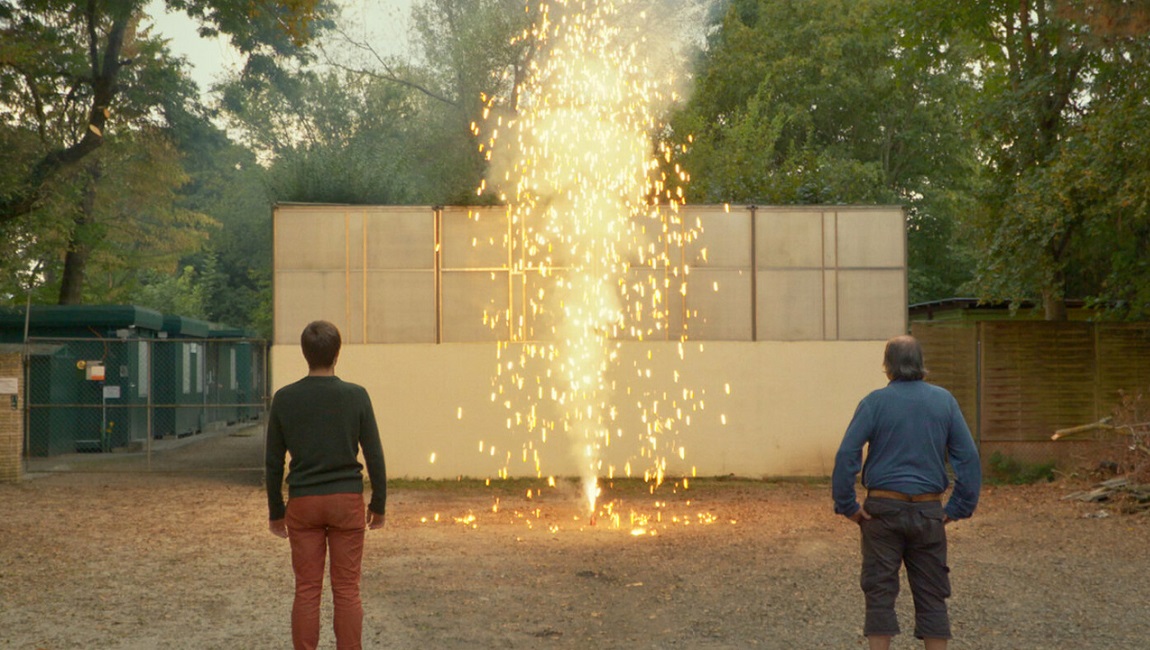Babatunde Apalowo’s feature debut, All the Colours of the World Are Between Black and White, is a moving portrait of gay desire, class, and masculinity. Set in present-day Lagos, Nigeria — which passed the Same Sex (Prohibition) Act in 2013 — the film’s sensitive depiction of queerness mourns the futures lost to systemic homophobia and makes a courageous statement on the precarity of gay existence. It follows a young man, Bambino (Tope Tedela), as he navigates his blossoming affection for a freelance photographer, Bawa (Riyo David). We’re first introduced to Bambino asking for a promotion; it is a blatantly one-sided conversation, one which presents an image of Bambino quite literally speaking to a wall. With the camera positioned at the doorway — never quite letting us see who Bambino is speaking to — Apalowo cleverly sets up Bambino’s struggle for recognition as a working-class gay man in Nigeria. Many of Bambino’s most mundane interactions are framed similarly: this is a man who is unable to make his demands heard. Apalowo, however, also makes clear that Bambino is not alone in his struggle; all around him are unhappy wives arguing with their husbands over failed arranged marriages, men who cannot pay the rent, and lonely women who feel crushed by their bleak futures. Bambino’s sexual repression is a displacement that has roots in an environment that’s not amenable to change.
Bambino’s sexual curiosity peaks when he chances upon Bawa, whose ambitions as a photographer are derailed by his circumstances. Like Bambino, who wishes to be an office manager instead of working the streets as a delivery rider, Bawa desires to work in a gallery but lacks the financial means to do so. The two’s desire for one another, while palpable, is perpetually bogged down by their grief over what could and should have been. These intimate conversations about their ambitions, which occur in expansive and bright places, offer a subtle and momentary glimpse of hope for queer men in Nigeria. Bawa’s loving photographs of Bambino, too, paint a richer future where artistic creation, which is crucial to imagining a better world, is freed from the confines of bigoted hatred and social cruelty.
The significance of photography in the cinematic portrayal of queerness is also present in Todd Haynes’ Carol, which uses Therese’s (Rooney Mara) passion for photography to highlight the inherent boldness of lesbian desire. Set in an era where a career in photography is seen as a frivolous pursuit for women, Carol’s (Cate Blanchett) genuine interest in Therese’s artistic passion is stunningly subversive; her desire for Therese actively brings a better world into being — one where women are not only allowed to be photographers but are also loved for who they are. In Apalowo’s film, Bawa’s dreams of becoming a photographer runs contrary to his actual dead-end job at a betting shop. Yet his affection for Bambino, fueled by their photo taking sessions together, re-ignites a passion that was once relegated to the margins. The two men never quite consummate their relationship, but it is precisely the realization of gay desire that makes all the difference between liberation and oppression. Apalowo’s All the Colours of the World Are Between Black and White is a striking and politically vital debut for what it dares to represent — the possibility of freedom.
DIRECTOR: Babtunde Apalowo; CAST: Tope Tedela, Riyo David, Uche Elemelu, Martha Ehinome; DISTRIBUTOR: Metrograph Pictures; STREAMING: June 7; RUNTIME: 1. hr. 32 min.
Originally published as part of InRO Weekly — Volume 1, Issue 7.5.







